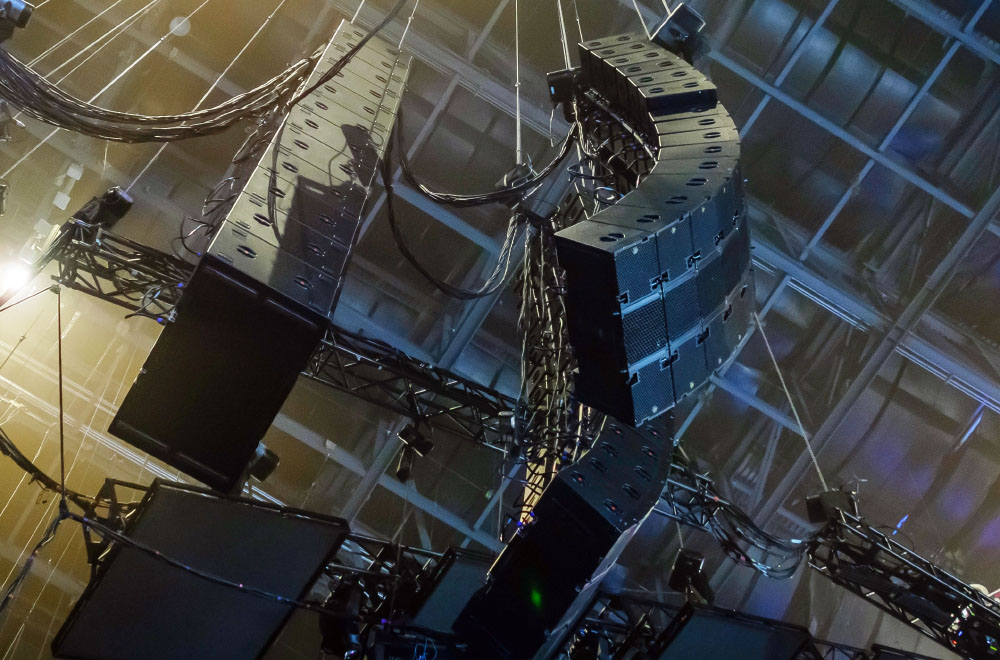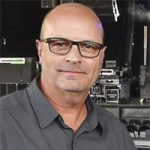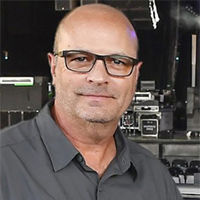Whether designing a sound system for a tour, festival or installation, the audio mixer and system engineer have many options when it comes to main and sub array design and implementation.
When considering sub bass loudspeakers, should they be flown or ground stacked? If flown, should they be located right next to the mains, behind the mains, or somewhere between the main and side arrays? Should a cardioid configuration be implemented?
As much as we try to put together the “perfect” PA system, these decisions are often made without the audio team having much to say about it. Set design, weight and sight lines (and oh yes… budget) can be contributing factors in what can be flown, and what must be ground-stacked.
Assuming none of these factors constrict the mixer and system engineer’s decision making, there are still many things to consider in designing the most powerful, coherent sound system suited to the engineer and artist’s desires. Let’s dive in!
Flown Or Ground Sub Arrays?
In other words, where do you want the boom? One benefit of flown sub bass loudspeakers is that the entire flown system covers the full spectrum of frequencies while emanating from the same point in space. With ground-stacked subs, there can be problems with varying arrival times of overlapping low frequencies depending on where you’re sitting in the audience in relation to the flown and ground speakers. With the subs flown next to the mains, varying arrival times are less likely or at least minimized.
For example, people sitting in the 10th row directly in front of one side of the ground subs will probably experience their energy arriving earlier than the flown main arrays. Conversely, people in the second tier of an arena are more than likely physically closer to the flown main arrays, so that energy will arrive at their ears first.
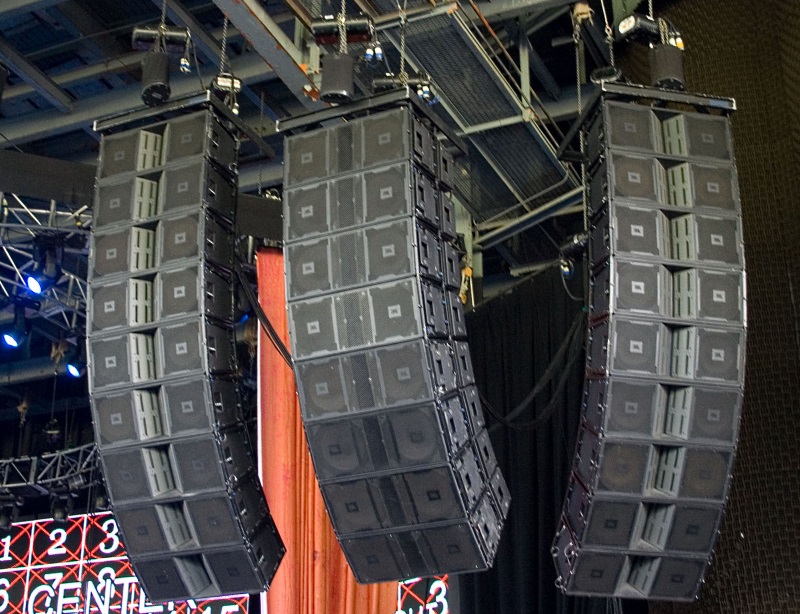
So, it leads to this question: At what location in the room do we choose as the spot to time-align the main loudspeakers to the subs when the subs are on the ground? The funny thing is that there’s really no “right” spot. It’s going to be slightly “off” everywhere except for the position where you timed it, so don’t sweat it. For the record, often my choice of location is the aisle just off center at front of house because it’s the most central part of the coverage when in an arena, but it’s not dead center.
Another thing to consider is how much signal should be sent to the sub bass loudspeakers, as well as whether it’s an artist and audience that appreciates being pummeled throughout the performance. For Metallica fans, this probably isn’t a problem, but a Sarah McLachlan audience may feel differently about it.
Flown subs reduce the distance differential from loudspeakers to audience so that everyone in the venue experiences a more even sub bass level. Ground-stacked subs have the advantage of coupling with the floor for some added horsepower, but the added “thump” will be strongest on the venue floor and not make it higher up in an arena. This may be what the mix engineer wants and insists on, however, even though it may not be the best thing for the overall audience experience.
To Overlap Or Not?
The next decision to consider is whether the sub bass loudspeakers are going to be taking care of the specific frequency range of 20 to 60/80 Hz by themselves, or whether the mains are designed and capable of overlapping some or all of the lower frequencies. With the subs flown next to the main and/or side arrays, the need to overlap frequencies may be reduced, although it may be the preference of a mix or system engineer to do this.
There are pros and cons, for sure. If the subs aren’t right next to the mains (physically), the overlapping frequencies will have different arrival times onstage to offstage, so some addition and cancellation issues can arise.
If the choice is to run a preset for the main and side arrays with a high-pass filter at, say 60 Hz, and the subs are low-passed at the same frequency, there will be less overlapping frequency problems. However, if the subs are ground-stacked, the top sections of the arena may be shy of those lowest frequencies, especially if the subs have a lot of bodies in front of them. This often happens at festivals or in arenas without floor seats.
If the choice is to run mains down as low as they’re able (say 40 to 50 Hz, or lower) the benefits can be more consistent low-frequency level throughout the venue that remains linear with the high and mid frequencies, adding cohesiveness to the frequency response of the entire PA. The sub bass loudspeakers could then be used as merely a “bass extension.”
The down side to this approach is a lack of control of the lower frequencies. With the main PA going all the way down to 30 or 40 Hz, a big rumble on stage can occur that can be troublesome for the artists and techs.
Cardioid Sub Arrays?
This brings us to the pros and cons of standard sub arrays versus cardioid pattern sub arrays.
With a cardioid sub configuration (where some of the subs are facing backwards, and polarity reversal and time delay are added to the rear-facing subs), the energy can be “steered” to the front of the sub array (where the paying public is) and significantly reduced behind the subs. This can be especially helpful with an artist who’s sensitive to low frequencies gathering on stage, or there are open mics (such as an orchestra or grand piano) to keep low frequencies away from.
With the help of prediction software that’s available from many loudspeaker manufacturers, the system engineer or audio mixer can “predict” the outcome and design cardioid sub arrays that reduce extreme low-frequency problems on stage as well as back areas where the monitor engineer and band techs may be stationed. Again, this is often determined by the preferences of the artist and their audience, as well as the mix engineer.
With a cardioid sub array (whether flown or ground-stacked), and main/side arrays that are frequency tailored to not overlap with the subs, a very clean-sounding stage can be attained while having all the sub bass and low frequency energy desired out front. Keep in mind that cardioid sub arrays, while very effective at controlling sub energy behind the cluster, may also reduce the sub bass energy on the sides of the stage where people are often sitting, especially in an arena layout.
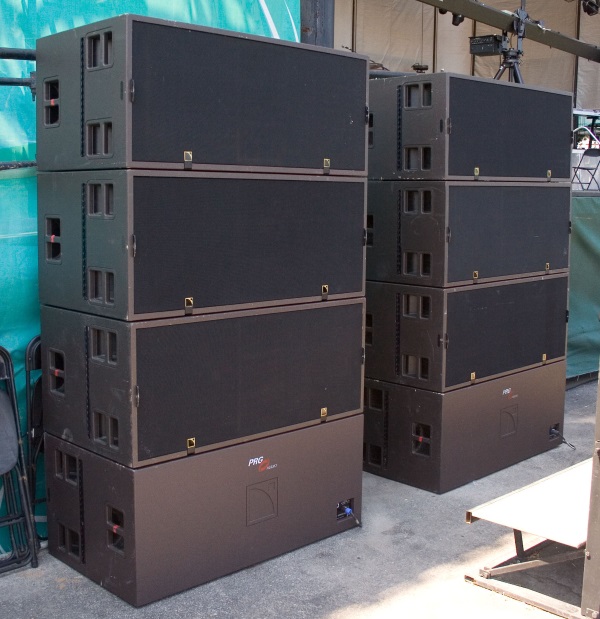
Diving even deeper, sub bass loudspeaker configurations (altering the location of the rear-firing subs) can be created to control where the “null” ends up on stage. The use of prediction software is great for steering the cancellation points and spreading the sub energy out over the audience area while avoiding walls and other obstacles.
Try aiming the ground or flown cardioid arrays with a slight “out angle” of 15 to 25 degrees. This can create a cancellation of sub bass on stage that can be directed toward certain musicians that may be more sensitive to low frequencies than others, or if they’re positioned straight out, it can make things quite nice for the monitor engineer and backline techs.
Time It, Tune It, Fini
After all of this information is considered and the best overall design is in place to cover the room adequately with full frequency response, power and clarity, time alignment and equalization are the final steps to ensure the best results. Time aligning zones of PA (mains, side arrays, subs and fill speakers) to work together as well as using zone EQ such as high-pass filters on side arrays and fill loudspeakers to reduce unwanted low end build up will be the finishing touches that bring the whole picture together.
The artist/band should also get a feeling of cohesiveness on stage that will make their experience better too, and in the end, they’re the ones signing your paycheck, so making them happy goes a long way.

